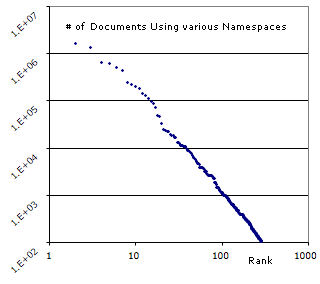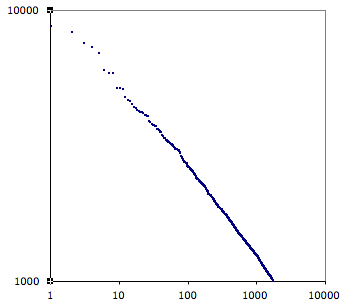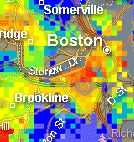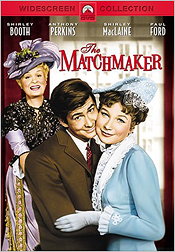This is yet another of those damn powerlaw scatter plots. This one illustrates the usage (market share?) of various namespaces used in RDF documents. This data is take from here with an overview here.

This pretty well sums it up:
In days past, these professional courtesies were almost necessary in building a strong agent/client relationship. Those days are long gone. At one time, it was a loving and trusting relationship built on mutual respect. But as with most modern relationships, the agent/client, once sacred bond, has been destroyed by the Internet.
I like to say that the intermediary must love both sides; that gets harder to sustain in a hurricane of disintermediation. Craig’s list and eBay don’t sport much relationship. Amazon’s model of your buying habits is the best you’re likely to get along those lines.
 AOL recently released a huge sample of search engine queries. In a highly questionable move they tied these queries to reasonably anonomous user identifiers; for example we know that user known as #724 searched for “how to install a glue down floor”, as well as “carbol tunnel” etc. He did 366 searchs between March 1st and May 5 2006.
AOL recently released a huge sample of search engine queries. In a highly questionable move they tied these queries to reasonably anonomous user identifiers; for example we know that user known as #724 searched for “how to install a glue down floor”, as well as “carbol tunnel” etc. He did 366 searchs between March 1st and May 5 2006.
Unsuprisingly the distribution of search generators is power-law distributed. This is a log-log chart. Each dot on the chart represents one AOL users. The vertical axis is how many searches they did; for example the highest dot, aka user 2263543, did 8695 searches. This is only the most active 20 thousand users in this data set, the least active of whom did 313 searches. The complete data set has 657 thousand users, 57 thousand of whom only did one search.
Actually I dropped the most prolific searcher, user #71845, who made over a quarter million searchs; and totally messes up my nice straight line.
Today is national mental health day. I think the most disturbing thing I’ve noticed as I browse this data is the number of people searching for information on how to commit sucide. There are effective treatments for depression.
 These heat maps of the price per square foot for real estate (in so far as they are accurate) are very cool. Cleveland appears to have very uniform prices (but that maybe dynamic range); while Chicago has very extreme ones.
These heat maps of the price per square foot for real estate (in so far as they are accurate) are very cool. Cleveland appears to have very uniform prices (but that maybe dynamic range); while Chicago has very extreme ones.
This is nicely complemented by this very old example of the same idea: London in the 1890s, which is a, I believe, just about the beginning of this kind of thinking.
But really it’s impossible to get a sense of the scale of things.
 LaLa, a matchmaker for for CD trading. Then here we have a software package for creating your own dating website should you want to become a match maker for this or that niche. One of thier clients is this site for “dog play dates.” I’m still frustrated that I’ve not found more examples from the natural world.
LaLa, a matchmaker for for CD trading. Then here we have a software package for creating your own dating website should you want to become a match maker for this or that niche. One of thier clients is this site for “dog play dates.” I’m still frustrated that I’ve not found more examples from the natural world.
Tree’s don’t get around much, but they still engage extremely syncrhronized behaviors. From time to time all the trees of a given species though out a region will decide to throw a party. These are known as mast years. In these years all the trees in the region will produce vastly more seeds than in other years. It’s an orgy! The distribution of seed production/year is highly skewed with the majority of seeds being produced in these mast years.
I’ve been thinking about power failures, in particularly electrical power failures. Random failures in the power grid pop up all the time, but with surprising regularity large swaths of the power grid fail. I suspect that if you had a plot of the # of customers-days of various failures you’d get a highly skew’d distribution. We know a fair amount of why these grid failures happen. The grid isn’t a grid, it’s a scalefree network. If it were more like a grid then it would be more robust; but a grid is expensive compaired to a scale free network. The grid failures arise because a random failure hits some reasonably key component and then the rest of the grid fails as the problem cascades thru the network.
For example last summer, or the summer before, we had a power grid failure across the megalopolis on the east coast of the North America. The network was running at capacity that hot day when something near Ohio failed. As the load shifted the safety triggers on other components decided that they should resign from the network – to protect themselves. Each resignation accelerated the cascade and soon a hundred million people were without power. I found that interesting at the time because it makes a link between the issues of pure go-it-alone self interested capitalism and the issues of collective good. We have been playing out a recent enthusiasm for handing public goods over to private actors here in the US. These private actors have trouble successfully coordinating the building of enough excess capacity and reliablity into their networks. As the network failures become more likely the individual actors, seeing that their capital equipment is more at risk, tend to shift their safety triggers down; or at least i presume they would.
This year we had a example that’s worse, in it’s way, of a power grid failure. The grid in Queen’s New York failed. This time it appears the the safety triggers were set too high. Again during record load a component failed; but this time as the failures cascaded other components stayed loyal to the network with the result that rather than resign they committed sucide. Which is way bad because to reboot the system they have to pull new cables to replace the ones that burnt out.
Both those models are, to be clear, entirely speculative. But I’d love to know if after the first failure the guys in Queens went around and readjusted thier safety triggers.
The mass years, presumably, are information cascades thru some communication channel the species members have stumbled upon. I bet that when they figure it out they will discover that larger groves of trees play a role in triggering a successfull cascade.
Trees, like other members of the ecology, are embedded in an web of inter-species relationships. Observers have noticed that the mass years throw quite a ripple thru that web. The squirrels get fat when oaks have a mass year. They have lots of offspring. The orgy cascades. The population bubbles and the next year it starves. This pattern is actually good for the oaks; who would like to get their seeds past those pests. During the abundant year many seeds get past the squirrels. The following year every acorn is found by now desperate squirrels. By the third year most of the squirrels have died and the oak can again get a lot of acorns past those pests.
I bet there are similar patterns in the supply chain web after each of these power failures. For example I bet there comes season a bit after a large grid failure when you can get a generator really cheap from a vendor who was fat and happy just a season ago.
A year or two ago I read just a little about honor cultures and came away quite dissatisfied. The dissatisfaction has been stewing in my head. Most of the literature about honor cultures is extremely dismissive or romantic, and mostly none of it talks about what problem the culture is solving.
So here’s a little model. I think honor societies arise to solve a problem the elite have when the wealth distribution becomes extreme. As this happens their position becomes increasingly risky. The number of slots at the top keep shrinking. The chance they will get back a slot if they lose it becomes vanishingly small.
Honor societies put a lot of calories into reputation management. Stains on your reputation create substantial risk that you might fall out of the elite. So the elite seek ways to formalize the reputation management. That creates demand and the market will fulfill that demand with products, rituals, certification, etc. etc. And, of course, the elite provide models for how to behave that are followed by everybody else.
Which sums up my guess about honor societies.
Much of what I read about honor societies confuses two things which we might describe as supply and demand. The problem outlined above is the demand – members of the elite desire things which will help to reduce the risk that they lose their status/reputation. The rituals that arise; e.g. dueling, killing your daughters, fastidious adherence to this seasons fashion in manners, test prep services, etc. etc. are the supply. Middlemen arise to fill this demand; and it seems to me that the literature about honor societies takes far too seriously the marketing brochures of these vendors.
There are plenty consequences of this model. It predicts that the honor societies ebb and flow with the distribution of wealth.
The effect should be stronger in societies with large families; because only some of your offspring are going to survive into the next round. If the family unit becomes the atomic economic unit rather than the individual; then honor killings (and the old French syndrome where a family can have their members thron in prison to protect the family’s honor) make more sense.
Note that increasing social mobility only makes things worse. As long as the option space is shrinking and the wealth distribution is extreme mobility only makes the chance of a long hard permanent fall greater.
Note the perverse way that as the rich strive to capture a larger share of the total economic pie the risks to their positions only increase.
A society undergoing a transition, as the US has been for the last 35 years, toward a more severe wealth distribution should see some members of the elite figure out the new rules before others. I.e. some members of the elite will lobby the government to get tools that protect their social standing sooner than other.
John Robb asks if Cars are becoming O/Ss. Absolutely not. Operating systems are intermediaries between hardware and software applications – two sided network effects. Cars with 700 page users manuals are becoming applications. Applications with very weak network effects. (As an aside their collision avoidance systems can have network effects since the more cars/planes/etc. that adopt them the more effective they become.)
Failing to find a auto-OS they can rendezvous around is not a particularly good architecture for the auto industry. Retaining control over that software frustrates innovation on both the hardware and user facing sides. I’m reminded of the old story of Adobe, who wiped out a lot of in-house printer software teams. Maybe somebody will do the same to the in-house auto application teams. A similar mess frustrates scale and innovation in the real time control industry.
Of course the most amusing element of all this would be terminology. Imagine a future where you can swap out your car’s engine for an alternate just as we swap graphic cards and disk drives on computers today. Of course at that point you couldn’t sit down and drive away until you loaded up some new drivers.
The end-to-end principle gets a pulled and stretched to serve many conclusions that it’s original statement didn’t actually encompass. That’s probably all for the best.
Here’s an article on Peer to Peer stock trading. Market hubs are a key example of the two sided network effects that support the emergance of the central points of control that enable regulation, taxation, and middlemen (to take a few examples).
Oh boy, mapping porn!. I just love this stuff! It is so very very hard to make reasonably visualizations of how data is distributed, particularly when that distribution is as skew’d as data typically is. I’ve written about the method used here before.